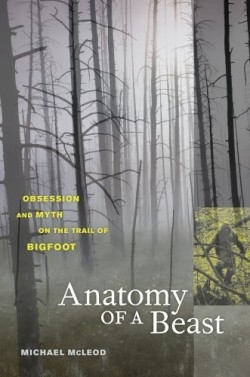Anatomy of a Beast
Obsession and Myth on the Trail of Bigfoot
America has a seemingly boundless supply of strange and unusual creatures within its borders, but people persist in finding extra mysteries in the large tracts of wilderness that still cover some corners of the country.
Bigfoot may be the most famous of these mysteries. For decades the mythical ape-man has captured the modern imagination and even skeptics might feel a shudder of primal recognition when confronted with—albeit questionable—evidence that evolutionary remnants of our biological past may still walk the earth alongside us.
Author Michael McLeod stands solidly in the camp of skeptic. His book, Anatomy of a Beast: Obsession and Myth on the Trail of Bigfoot, isn’t actually about Bigfoot. It’s about the men who perpetuated the myth and how a few fake tracks snowballed into a national obsession that continues almost fifty years after Bigfoot fever reached its peak. The beast referred to in his title could very well be the legend itself.
Roger Patterson, Roy Wallace, Rene Dahinden, Peter Byrne, John Green, and Ivan Sanderson were star Bigfoot hunters back in the 1960s. They found or faked enough circumstantial evidence to garner global attention and convince many people that monster was real. Their proof included plaster casts of footprints, sightings of actual beasts, and interviews with witnesses. For years, these men and many others searched the northwest corner of the country with dogged resolve. They found only hints and clues, footprints and damaged machinery, and glimpses of something that could be Bigfoot, or could be a bear.
The most intriguing and controversial piece of evidence is the film made by Roger Patterson and his assistant, Bob Gimlin, in which Bigfoot stalks across a clearing, at one point gazing directly into the eyes of the viewer. For decades this film has been held up as proof of Bigfoot’s existence. McLeod shows through careful examinations of the stories of what happened that day and by retracing the filmmakers steps that Patterson and Gimlin could not possibly have made the film when and how they said they did.
But why would grown men go to such lengths to convince people of the existence of Bigfoot? Money? Fame? A psychological need to believe in something larger than oneself, even if it could only be proved through treachery? In Roger Patterson’s case, his own race with death-he suffered from Hodgkins disease-surely applied extra pressure to prove to the world that his enduring obsession was a worthwhile one. McLeod explores, with prose thats both sensitive and probing, this very human tendency to see pictures in the clouds, UFOs in the sky, and fragments of evolution in the woods.
McLeod excels at writing about the wilderness. His descriptions of the Klamath National Forest and the Six Rivers National Forest are chilling and lend a certain credence to the idea that something must be out there: The forest vanished suddenly, he writes, leaving only scrub brush and scattered splinter pines growing at odd angles from angular stone surfaces glazed with a sheen of ocher and burnt umber. The landscape he describes is a dangerous and unwelcoming one, a place where one might not trust ones own senses to explain what seems unexplainable, like gigantic footprints or horrific screams.
When writing about the people involved in the search for Bigfoot, McLeod tends to err on the side of respect, with a healthy dose of skepticism to keep readers informed of his stance on the debate. His descriptions often include razor sharp one-liners that are both funny and insightful. About Roger Pattersons assistant investigator, Dennis Jenson, he writes, Jenson today lives with a naked parrot he refuses to call a pet in a cabin near the scene of many of his Bigfoot adventures… Footnotes contain further tangential gems and should not be skipped. Also, a series of photos of the famous Bigfooters lend a sense of humanity to men who might otherwise seem like slightly pathetic, obsessive tricksters.
Therein lies the nexus of the Bigfooter conundrum: an inexplicable blindness to the vagaries of the human animal, a state of mind that can only be explained by the adage that people believe what they want, McLeod writes. Though his arguments against Bigfoot are based purely in reason and clear deduction, one almost gets the sense that McLeod would like these men who believed so passionately in the monster in the woods to be right. He recognizes, though, that often the greatest mysteries are those that thrive within our own minds, our own souls.
Reviewed by
Andi Diehn
Disclosure: This article is not an endorsement, but a review. The publisher of this book provided free copies of the book to have their book reviewed by a professional reviewer. No fee was paid by the publisher for this review. Foreword Reviews only recommends books that we love. Foreword Magazine, Inc. is disclosing this in accordance with the Federal Trade Commission’s 16 CFR, Part 255.

